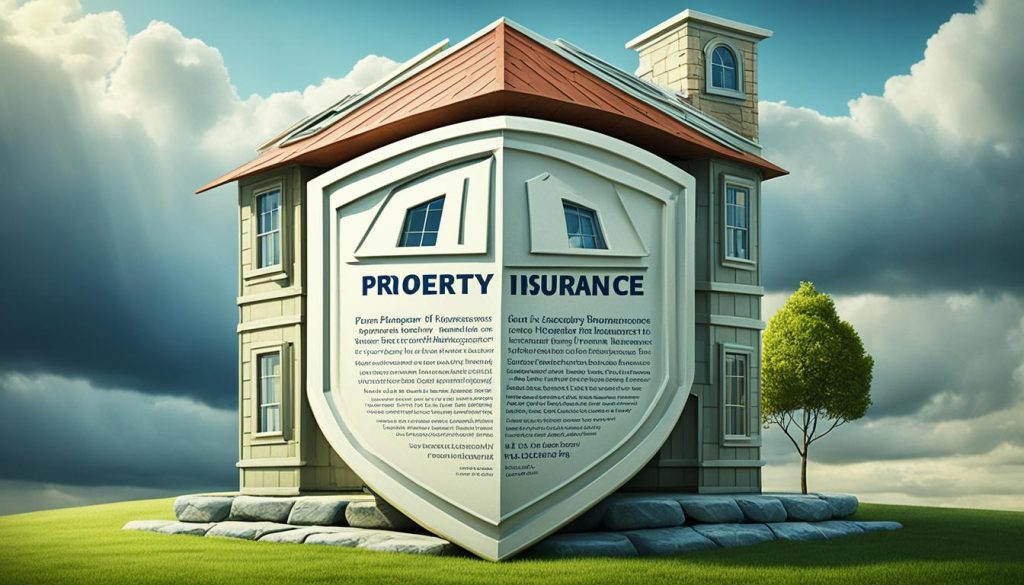Getting comprehensive1 Property Insurance is key to keep your home and valuables safe. It helps you avoid financial losses from accidents, natural disasters, theft, or liability claims1. By knowing the different types of coverage, understanding your risks, and handling claims well, you can make sure your assets are safe.
Key Takeaways
- Understand the importance of property insurance in safeguarding your assets
- Familiarize yourself with the different types of property coverage, including homeowner’s and rental property insurance
- Assess your risks and ensure you have adequate coverage to protect your home and valuables
- Learn about the claims process and how to navigate it effectively
- Explore strategies to balance your property insurance needs with affordable premium costs
The Importance of Property Insurance
Property insurance is key to managing risks. It shifts the cost of potential losses to an insurance company2. It’s crucial for protecting your home, belongings, and rental properties from unexpected events2.
Safeguarding Your Investments from Unexpected Losses
Understanding property coverage lets you customize your policies for your risks. Homeowners insurance covers things like fire damage and theft3. But, it doesn’t cover flood damage, earthquake damage, or mold2.
Liability coverage is vital, covering damage to others’ property and medical bills from injuries on your property2. Home-based businesses need their own policy for coverage2.
Understanding the Different Types of Property Coverage
There are many property insurance policies, each with its own coverage3. The HO3 policy covers 16 perils, including fire and theft3. HO5 policies cover the home and its contents but not earthquakes or floods3. HO4, or renters insurance, covers personal property and liability but not the rented house3.
Replacement cost coverage pays to fix or replace property at today’s value3. Actual cash value coverage pays less, subtracting depreciation3. Extended replacement costs pay more if construction costs have gone up, up to 25% of the limit3.
Property insurance is very popular today, showing people’s efforts to protect their properties4. Different policies are for different properties, like shipyard or car insurance4. Having home insurance can make you more eligible for bank loans, showing a link between insurance and loan approval4.
“Investing in property insurance is essential for safeguarding your assets and ensuring financial stability in the face of unexpected events.”
In conclusion, property insurance is key for protecting your investments and belongings from unexpected losses. By choosing the right coverage, you can keep your assets safe and secure your financial future234.
Homeowner’s Insurance: A Necessity
As a homeowner, it’s crucial to protect your biggest investment. Homeowner’s insurance is key, covering your home’s structure and your belongings5. It helps fix or rebuild your home if damaged and replaces stolen or destroyed items.
Dwelling Coverage for Your Home’s Structure
Dwelling coverage is the core of homeowner’s insurance, protecting your home’s structure6. Lenders often require it before financing a home, ensuring your property can be fixed after damage from fire, storm, or vandalism5. It also covers other structures like a detached garage or shed, giving you peace of mind.
Personal Property Protection for Your Belongings
Homeowner’s insurance also protects your personal items from theft, damage, or loss5. It covers many items, from furniture and electronics to clothes and valuables6. If a covered event happens, your insurer will pay to replace your items, helping you get back what you lost.
| Coverage Type | Typical Limits |
|---|---|
| Dwelling Coverage | Minimum $300,000 to $500,0005 |
| Personal Property | 50% to 70% of dwelling coverage amount6 |
| Personal Liability | $100,000 to $500,000 or more7 |
| Medical Payments | $1,000 to $5,0007 |
With enough homeowner’s insurance, you protect your home and belongings from harm5. Don’t risk leaving them exposed. Look into your homeowner’s insurance options today.
Liability Protection: A Must-Have
Liability protection is key when you want to keep your assets safe. It covers damages you cause to others, like injuries or damage to their property. This protection helps keep your personal and business assets safe from big legal costs after accidents.
Having enough liability coverage is vital for your financial health8. Experts say you should aim for $300,000 to $500,000 in coverage to protect yourself from lawsuits9. Businesses, especially those run by one person, might need even more because owners can be personally liable for business debts.
Liability protection isn’t just for personal assets8. Employers must have employer’s liability and workers’ compensation insurance8. Product liability insurance helps cover lawsuits from injuries or deaths from products. Indemnity insurance covers financial losses from mistakes, and director and officer liability protects the board from lawsuits.
For people10, personal liability coverage is often part of homeowners insurance10. It helps cover accidents on your property. You can buy more coverage with an umbrella policy to increase your limits.
It’s important to think about your risks and what your assets are worth to figure out how much liability protection you need9. Knowing the chances of accidents or property damage helps you choose the right liability insurance amount9. For small businesses, it’s better to have more liability insurance than property insurance to protect your money in case of a lawsuit.

Getting strong liability protection is a must for any property owner or business. The right coverage means your assets are safe from legal judgments and their costs. Don’t risk your financial future – make sure to include liability protection in your insurance plan8910.
Assessing Your Risks: The Key to Adequate Coverage
Figuring out how much property insurance you need starts with a clear look at the risks and threats to your property. Insurance companies look at things like where your property is, what it’s made of, how old it is, and how safe it is. They use this info to figure out how likely you might need to make a claim11. Knowing what risks your property faces helps you make sure you have enough insurance to fix or replace it if something happens.
Identifying Potential Threats to Your Property
Where your property is located is key to understanding its risks. If it’s in an area often hit by natural disasters or high crime, you’ll need to think about that. The age and condition of your home also matter, as they can lead to issues like leaks or electrical problems. By looking at these things, you can spot the dangers to your property and get the right Risk Assessment and Property Valuation coverage.
Evaluating the Value of Your Assets
It’s important to know how much it would cost to replace your home and what your stuff is worth. This helps you get enough Asset Protection and Insurance Coverage. Insurance costs depend on things like how much your home costs to replace, how much coverage you want, and your deductible11. There are different kinds of policies, like HO-3 or HO-8, that fit your property’s needs11.
Insurance companies have rules to figure out if they’ll accept your risk and how much it’ll cost11. They use complex models to predict claims, making risk assessment better11. Good underwriting helps companies manage risks, keep costs down, and offer solid coverage to homeowners, keeping the financial system stable11.
By figuring out what your assets are worth, you can make sure your insurance covers enough to fix or replace them if something happens. This way, you get the right Asset Protection and Insurance Coverage for your needs111213.
Natural Disasters and Property Insurance
Natural disasters can threaten your property and financial well-being. Events like floods, earthquakes, and severe storms can cause huge damage. This damage can hit you hard, both emotionally and financially14. Standard homeowner’s insurance might help, but it’s key to know its limits. You should look into extra coverage to protect your investments15.
Protecting Your Home from Nature’s Wrath
If you live in a risky area, you might need more than a standard homeowner’s policy. You might need flood or earthquake insurance14. Earthquake insurance costs about $850 a year, depending on your home’s details and location14. Flood insurance is around $859 annually, says Forbes Advisor14.
Some policies don’t cover damage from certain natural disasters, like wind damage14. In these cases, you might need a separate policy or add-on for full protection14. Deductibles for these coverages can be high, especially near the coast, with some going up to 10% for hurricanes14.
Think about extra coverage like extended replacement cost coverage. It can cover up to 25% more than your policy’s limit for rebuilding after a disaster14. Or, consider guaranteed replacement cost coverage, which pays for full rebuilding costs14.

After a disaster, dealing with claims and getting disaster help is key14. You’ll need to give details about the damage and your insurance and income14. Some losses, like food spoilage and debris removal, might not be covered by insurance. So, it’s vital to know your policy well14.
With the right insurance policies, you can protect your home and assets from nature’s surprises15. With more frequent and severe disasters, it’s crucial to act now to keep your investments and financial stability safe151416.
Rental Property Insurance: Safeguarding Your Investment
As a real estate investor, it’s key to protect your rental properties17. With about 19.4 million people living in New York, the need for rental homes is high, especially in cities and college towns17. Rental property insurance, or landlord insurance, is vital. It covers the building, protects you from lawsuits, and helps if you lose rental income.
In New York, rental properties face special challenges like old buildings and strict tenant laws17. Landlord insurance can lessen these risks. It covers damage from fires, storms, vandalism, and issues with tenants18. This policy also offers legal help in disputes with tenants, giving you peace of mind and financial safety.
Even though landlord insurance isn’t required in New York, it’s a smart choice for property owners17. It can cover lost rental income if the property can’t be lived in, keeping your investment safe18. Your insurance cost can change based on the property’s location, condition, past claims, coverage limits, and deductibles17.
With the right rental property insurance, you can protect your investments and lessen the blow of unexpected events18. Whether you have a single rental or many, the right insurance is key for success as a landlord.
“Landlord insurance offers legal protection for landlords during disputes with tenants, giving you peace of mind and financial security.”18
In summary, rental property insurance is a must-have for New York real estate investors171819. Knowing the risks and benefits helps you make smart choices to protect your rentals and keep your investment profitable.
The Claims Process: What to Expect
Understanding the claims process is key with property insurance. If you face a loss like theft, fire, or a natural disaster, you must file a claim with your insurer. You’ll need to provide detailed info about the loss and work with the insurer’s investigation. Following the right steps helps ensure your claim is handled quickly and successfully20.
Filing a Claim the Right Way
To file a claim right, collect and send the right info to your insurer. This includes written details, a list of damaged items, photos, your property lease, police reports if needed, and receipts or invoices for repairs20. Most policies want claims filed within a year of the incident21.
Navigating the Claims Process Smoothly
After filing, the insurer will send an adjuster to check the damage in a few days20. The adjuster will look at the damage and offer a settlement based on your policy and deductibles. If you’re not happy with the offer, you might need to negotiate with the insurer20. Keeping good records is key for taxes and any future issues20.
The claims process can be complex, with extra steps like emergency repairs, separate checks for structure and belongings, and dealing with lenders or management companies if they have an interest in the property21. Knowing the process and being ready can make it easier and increase your chances of getting full compensation under your policy.

“Reporting a claim as soon as possible allows the insurer to help sooner.” – Travelers22
Property Insurance Rates: Finding the Right Balance
Finding the right property insurance is like balancing coverage and cost. Many factors can change your property insurance rates. It’s important to know these to pick the best policy for you23.
Factors Affecting Your Premium Costs
Your property’s value, location, and its age and condition affect your premium costs. Insurers look at ZIP code, vandalism rates, and how close you are to fire stations to set your rates23. Your claims history, credit score, and even if you’re married can change the insurance discounts you get23.
People with good credit and no claims history pay less for property insurance. Older homes and those in risky areas pay more23. Making your home safer or more energy-efficient can also get you insurance discounts23.
Choosing the right deductible is a smart way to lower your premium costs. A higher deductible means lower monthly payments but you must be able to pay it if you make a claim23. Some insurers offer lower deductibles if you haven’t made any claims recently, which can save you money23.
| Factor | Impact on Rates |
|---|---|
| Property Value | Higher property values lead to higher premiums |
| Location | Areas prone to losses, such as natural disasters, experience higher rates |
| Home Age | Older homes often have higher premiums due to aging materials and potential code upgrades |
| Claims History | Frequent claims can result in rate increases |
| Credit Score | Good credit is associated with lower insurance premiums |
| Deductible | Higher deductibles can lead to lower monthly premiums |
Understanding these risk factors and the insurance discounts you can get helps you find a good balance. Reviewing your policies and shopping around can also help you get the best deal232425.

“Finding the right balance between coverage and cost is crucial when it comes to property insurance.”
Property Insurance and Risk Management
Property insurance is key to a solid risk management plan. It shifts the risk of loss to an insurance company, protecting your assets and financial health26. But, knowing what insurance doesn’t cover is crucial. You should also use emergency funds, diversify your investments, and use legal structures like trusts and corporations27. Mixing property insurance with a full risk management plan helps protect your investments and keeps your finances stable26.
Managing risk means checking contracts and leases for the right insurance, reviewing how your business runs, and looking at claims26. Experts create programs to prevent losses, covering things like slip and fall accidents and workplace violence26. They also make plans to keep employees safe, protect your market share, and keep your brand good, even if things go wrong26.
Managing property risk means making plans to keep your assets safe and growing, while cutting down on insurance costs27. Commercial property insurance covers losses from fires, natural disasters, theft, and vandalism27. It’s important to understand climate trends to protect people and property from climate change27.
Captives can be a powerful tool for managing property risks, letting you tailor how you handle risks28. Deductibles can help lower the costs of fixing property damage and business interruptions28. Having separate coverage for risks like wind, earthquake, and flood is key to protecting your assets28. Parametric products offer new ways to handle risks by meeting certain conditions28.
Risk modeling and analytics help figure out risks, find gaps, and improve how you handle them28. Global insurance hubs make it easier to find markets and capacity for tough risks28. Having claims advocates can speed up settling claims and make sure they’re handled well28.
Conclusion
It’s key to protect your assets with comprehensive property insurance for your investments and financial stability29. Knowing the types of property coverage and understanding your risks helps. This way, your home, belongings, and rental properties are well-protected293031.,,
Property insurance is part of a bigger risk management plan. It’s important to mix it with other asset protection steps for a strong financial safety net against surprises31. Being proactive with property insurance and risk management gives you peace of mind. You’ll know your assets are safe.
Choosing comprehensive property insurance is a smart move. It gives you the financial stability and protection your assets need293031.,,
FAQ
What is the importance of having property insurance?
Property insurance is key to protecting your assets and financial well-being. It covers unexpected losses, transferring risk to an insurance company. This ensures your home, belongings, and rental properties are safe.
What are the different types of property insurance coverage?
Property insurance comes in two main types: homeowner’s insurance and liability insurance. Homeowner’s covers your home and belongings. Liability protects you from damages to others. You might also need flood or earthquake insurance based on your location and risks.
Why is homeowner’s insurance a must-have for any homeowner?
Homeowner’s insurance is vital for protecting your home and belongings. It covers the structure and your stuff. This keeps your biggest investment and personal items safe from damage, theft, or other issues.
What is the importance of liability protection in a property insurance plan?
Liability protection is key in property insurance. It covers damages you cause to others, like injuries or property damage. Having enough liability coverage protects your assets from legal costs after accidents on your property.
How do I determine the appropriate level of property insurance coverage?
To find the right property insurance coverage, assess your risks and threats. Consider your home’s location, its age and condition, your belongings’ value, and natural disaster risks. Knowing your assets’ value helps set coverage limits to replace or repair them after a loss.
How can natural disasters impact my property insurance coverage?
Natural disasters like floods, earthquakes, and storms can damage your property and belongings. Standard homeowner’s insurance might not fully cover these losses. You might need extra coverages, like flood or earthquake insurance, to protect your home and assets fully.
Why is rental property insurance important for landlords?
Rental property insurance is crucial for landlords to protect their investment. It covers the rental unit and protects you from liability for accidents or injuries. It also covers lost rent if there’s a covered loss, keeping your investment safe.
What should I know about the property insurance claims process?
Knowing the claims process is key with property insurance. If you face a covered loss, like theft or damage, file a claim with your provider. You’ll need to document the loss, work with the company, and follow their steps for a successful claim.
What factors can impact my property insurance premium rates?
Many things can change your property insurance rates, like your property’s value and location. The age and condition of your home, claims history, and deductibles also play a part. By understanding these and looking for discounts, you can get good coverage at a fair price.
How does property insurance fit into a comprehensive risk management strategy?
Property insurance is a key part of managing risks. It transfers potential loss risks to an insurer, protecting your assets and financial stability. But, know its limits and add extra protection like emergency funds and legal structures. With property insurance and a full risk management plan, you can protect your investments and stay financially secure.
Source Links
- The BIG Misconception About How Insurance Protects Your Assets – Medicaid, Asset Protection Trusts and Estate Planning Law Firm – Greensboro, NC
- The Importance of Property Insurance
- Property Insurance: Definition and How Coverage Works
- Importance of Florida Homeowners Insurance – Chapman Insurance Group
- Do I Need Homeowners Insurance and When Should I Buy It? | Travelers Insurance
- Homeowners Insurance Guide: A Beginner’s Overview
- Is Home Insurance Required? What Homeowners Need To Know | Bankrate
- Liability Insurance: What It Is, How It Works, Major Types
- How Much Property and Liability Insurance is Enough for Your Business?
- What Is Personal Liability Insurance? | Bankrate
- Understanding Home Insurance Underwriting: Assessing Risks and Determining Coverage
- How do insurance companies assess risks? 🔍⚠️
- Risk Management and Insurance – Protea
- Does Home Insurance Cover Natural Disasters?
- The Impact of Natural Disasters on Insurance Rates in 2024 | Bankrate
- Insurance for Disasters – LSC Disaster Website
- A Guide to New York Landlord Insurance – Azibo
- Safeguarding Your Rental Investment: The Importance of Investment Property Insurance
- Property Insurance : Safeguard Your Investment
- Property Damage Insurance Claims Process: What To Expect | LandesBlosch
- Understanding the insurance claims payment process
- How the Home Insurance Claim Process Works | Travelers Insurance
- Factors That Impact Your Cost of Homeowners Insurance | Bankrate
- 20 Factors That Affect Property Insurance Rates
- How to estimate your home insurance cost | Bankrate
- Property and Casualty Risk Management
- Property Risk Management | Aon
- Property Risk and Insurance Solutions
- Property Insurance: Coinsurance
- What Is Ordinance or Law Coverage? – Harry Levine Insurance
- Understanding EML and PML: The Dilemma Facing Policyholders in Property Insurance

